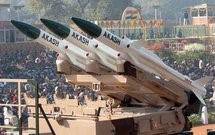 One can only be bemused by Prime Minister Manmohan Singh’s exhortation while inaugurating a recent conference on nuclear disarmament that the need was to establish a global no-first-use convention relating to nuclear weapons. His relevant remarks are:
One can only be bemused by Prime Minister Manmohan Singh’s exhortation while inaugurating a recent conference on nuclear disarmament that the need was to establish a global no-first-use convention relating to nuclear weapons. His relevant remarks are:
“More and more voices are speaking out today that the sole function of nuclear weapons, while they exist, should be to deter a nuclear attack. If all states possessing nuclear weapons recognise that this is so and are prepared to declare it, we can quickly move to the establishment of a global no-first-use norm. In many ways, this can open the way to gradual reductions and, finally, elimination through a Nuclear Weapons Convention. Such a Convention would require necessary verification measures. It would also require political measures to ensure that stability is maintained as the level of nuclear arsenals approaches zero.”
Why Manmohan Singh chose to make this radical declaration in the twilight days of the UPA government after its insouciance over the last ten years can only be speculated upon, especially when all bets are off about its returning to power after the forthcoming elections. It is also unfortunate that, shortly thereafter, two kiss-and-tell-all biographies published by former aides of Manmohan Singh have further dented his soiled image.
Moreover, the historical record informs that India’s ‘no-first-use’ policy owes, not to the Congress and UPA, but to the BJP party and NDA government that took the decision to conduct the nuclear tests in May 1998. Shortly thereafter, the incumbent Prime Minister, Atal Behari Vajpayee, declared that India would pursue a no-first-use policy in regard to employing nuclear weapons, which was later reaffirmed in a statement before Parliament in December 1998. This pledge was reiterated in the draft nuclear doctrine issued for public discussion in August 1999, and later incorporated into the decisions of the Cabinet Committee on Security (CCS) promulgated in January 2003.
This potted history of how India’s ‘no-first-use’ policy evolved clarifies that it was a BJP innovation; it was adopted by the Congress Party, which is now seeking its global remit. However, India's pledge not to be the first to use nuclear weapons was severely qualified. It is thus unclear whether Manmohan Singh was promoting the Indian version or a ‘no-first-use’ pledge in its pristine purity. This conundrum needs an explanation.
• First, the CCS decision of January 2003 made clear that India would not use nuclear weapons against non-nuclear weapon states, which left open the question how India would respond if a nuclear weapon state positioned its nuclear weapons in a non-nuclear weapon state for and utilisation against India. Very conceivably, Afghanistan could host nuclear weapons belonging to China or Pakistan that could target India.
• Second, the CCS decision also mentions that “in the event of a major attack against India, or Indian forces anywhere, by biological or chemical weapons, India will retain the option of retaliating with nuclear weapons.” A host of problems arise here. How does one define ‘major’? Would a cross-border raid or air attack qualify? Would a Mumbai-type attack be considered ‘major’? Or, would ‘major’ only include a full-scale conventional attack employing all arms and services of the national armed forces? Does that rule out sub-conventional warfare and attacks by non-state actors which constitutes the present and imminent danger?
• Third, this problem gets more complex when applied to chemical and biological weapons, since the tricky question of forensics enters the equation. How can a nation ascertain with certainty the identity of the attacker, which could be either a non-state or state actor? Or, a non-state actor promoted by a state actor. Current happenings in Syria underline this dilemma of identifying the attacker.
To contextualise these issues is germane: How do China and Pakistan treat the ‘no-first-use’ issue? China declared its ‘no-first-use’ pledge immediately after conducting its first nuclear test in October 1964. But, it later excluded its own territories from the ambit of this declaration. The catch here is that China believes Taiwan and Arunachal Pradesh are parts of its territory, the implication being that, if the conflict extended into these ‘disputed’ territories, China was entitled to use nuclear weapons.
Pakistan, of course, has never countenanced the ‘no-first-use’ doctrine urging that the weaker conventionally armed power has to rely on nuclear weapons to assure its security. Incidentally, the NATO powers had steadfastly abjured a ‘no-first-use’ declaration during the Cold War years, despite the Soviet Union making this pledge, on the premise that the Warsaw Pact powers possessed superior conventional forces that could overrun Europe. No doubt, this example also informs Pakistan’s decision to deploy tactical nuclear weapons in a battlefield mode to counter India’s Cold Start strategy.
Many loose ends must be tied up before proceeding with Manmohan Singh’s fervent plea to establish a global no-first-use convention. More thought would need to be bestowed by New Delhi’s next rulers to decide whether and how to review this ‘no-first-use’ pledge in the broader context of India’s nuclear doctrine that has remained unvisited since 2003.
By Special Arrangement with : Institute of Peace and Conflict Studies (http://www.ipcs.org)